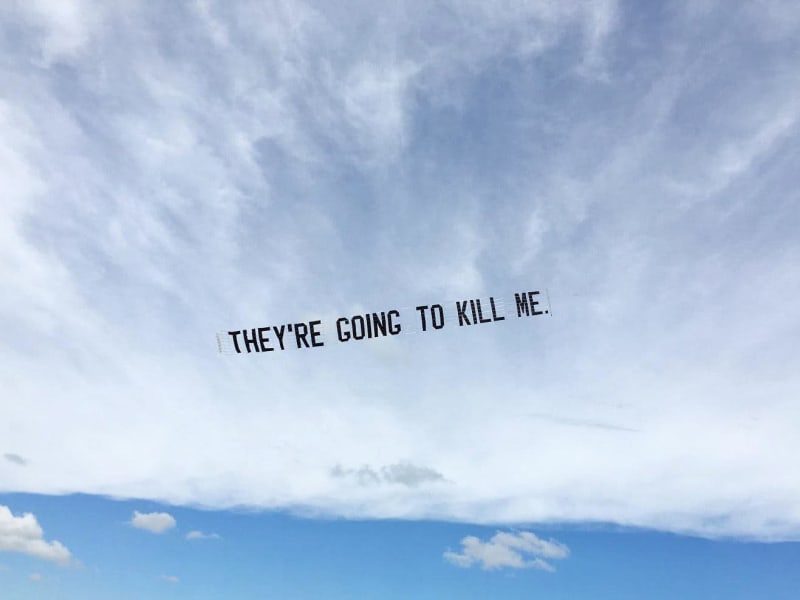BY HILARY MOSS
Just after 12:30 p.m. on Saturday, as cooped-up New Yorkers spilled onto the Battery Park City esplanade — most in groups of two or three, each stationed a safe distance apart — a small plane glided past the Statue of Liberty and into view over the Hudson River. A banner swelled behind it, which read, “They’re Going to Kill Me.” These were among the last words of George Floyd, a black man who was killed while in the custody of the Minneapolis Police Department on May 25, and whose death has spurred demonstrations all over the country.
Similar banners, each emblazoned with more of Floyd’s final words, billowed behind planes above a handful of cities across the United States: The sentence “Please I Can’t Breathe” could be seen circling downtown Detroit while “My Stomach Hurts” loomed overhead in Miami; the phrase “My Neck Hurts,” flying atop a peaceful protest in Dallas, made local news as “Everything Hurts,” seen later in photos posted on social media, stood out against the gray Los Angeles sky.
The aerial demonstration was the work of Jammie Holmes, an emerging Dallas-based artist. “I thought this was a better way of getting the message out” than taking action on the ground, he said in a phone interview, mentioning that plane banners are mostly used in the area where he lives to advertise for golf tournaments. “Or you’ll see something like, ‘Will You Marry Me?’ It’s always controlled by the rich.” After watching some of the footage of the now former police officer Derek Chauvin kneeling on Floyd’s neck as he pleaded for his life and finally became unresponsive, Holmes approached Library Street Collective, a gallery in Detroit that began representing him in April, to back the idea financially. It all came together in 48 hours. In a statement published on his website, the artist described the project as “an act of social conscience and protest.”
Being black in America is a theme that Holmes, 36, explores often in his paintings — which are collected by the musician Lenny Kravitz, the curator Beth Rudin DeWoody and Kevin Lee, a.k.a. Coach K, the founder of Quality Control Music. Holmes’s canvases portray black figures in scenes from everyday life, surrounded by graphic abstractions and swaths of color. In “Mama Raised Me” (2020), his mother, smiling and dressed in red, sits on a beige sofa next to a box fan; a ghostlike smiley face, a rough sketch of a house and the crossed-out phrase “We Happy Here” fill out the composition. Another recent painting, “Endurance” (2020), depicts Holmes cutting his younger brother’s hair in front of a floral panel. “I put flowers behind us because I wanted to tone down the black in us,” Holmes said. “I’m 6-foot-3, bearded with tattoos, and I love jewelry. I wanted us to look safer. It’s sad that we have to live like that — it’s why I always ask, ‘When can I live like you?’”
Holmes grew up in Thibodaux, La., a small city on the banks of Bayou Lafourche, known for an 1887 massacre in which the all-white state militia and vigilantes slaughtered scores of black farm workers who were on strike. “Those bodies are buried under the houses that we lived in,” Holmes said. “That blood is in the soil, so that place hasn’t changed.” He described himself as having been “an angry kid” who put pencil to paper as a means of escape, drawing portraits or still lifes of flowers to decorate birthday or Mother’s Day cards; upon seeing one of his sketches of Bob Marley, Holmes’s cousin told him that he had million-dollar hands.
But he resisted any formal training. Following his graduation from high school, he ultimately enlisted, and spent four years, in the army. Then he got a job at an oil field in Schriever, La., where he worked for 14 years, eventually becoming a supervisor, while painting on the side. He relocated to Dallas in 2016 and left his position as a quality engineer at the heat-sink manufacturer Alexandria Industries last year, once he realized he was consistently selling his paintings. It was also around this time that, at the urging of his fiancée, the artist Abi Salami, Holmes entered therapy. Salami, he said, “told me, ‘Until you know how to control your anger, you will never be the leader that you say you want to be, and that I know you can be.’” He noted that by working things out on the canvas, he has been “able to start closing some of the doors to what has been hurting me.”
His “They’re Going to Kill Me” project over the weekend might seem like a major departure for an artist just gaining recognition for his figurative paintings, but this was a different way for Holmes to put himself out there. “The only thing that I know how to do is use my platform as an artist,” he said. “I decided to use that, and the people I know, and try my damnedest to put all of this on a bigger screen.”


